
(a)
Interpretation:
The detailed mechanism for the given reaction is to be drawn and the major product of the reaction is to be predicted.
Concept introduction:
The addition reaction mechanism dominates on whether the nucleophile adds to the carbonyl carbon reversibly or irreversibly. Nucleophilic addition is irreversible or reversible depends on charge stability. Nucleophilic addition tends to be irreversible if the negative charge that develops in the adduct is substantially better stabilized than it is in the nucleophile. Nucleophilic addition to a carbonyl carbon tends to be irreversible when it involves a very strong nucleophile like
Answer to Problem 17.24P
The major product and mechanism for the given reaction are:
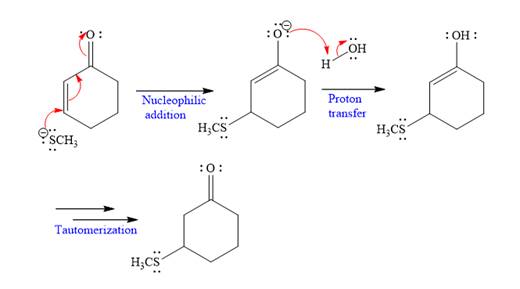
Explanation of Solution
The nucleophile
In the first step,

In the second step, this enolate anion is then protonated by an acid workup.

In the last step, tautomerization takes place and produces a ketone with a conjugate addition product.

Nucleophilic addition of
(b)
Interpretation:
The detailed mechanism for the given reaction is to be drawn and the major product of the reaction is to be predicted.
Concept introduction:
The addition reaction mechanism dominates on whether the nucleophile adds to the carbonyl carbon reversibly or irreversibly. Nucleophilic addition is irreversible or reversible depends on charge stability. Nucleophilic addition tends to be irreversible if the negative charge that develops in the adduct is substantially better stabilized than it is in the nucleophile. Nucleophilic addition to a carbonyl carbon tends to be irreversible when it involves a very strong nucleophile like
Answer to Problem 17.24P
The major product and detailed mechanism for the given reaction are:
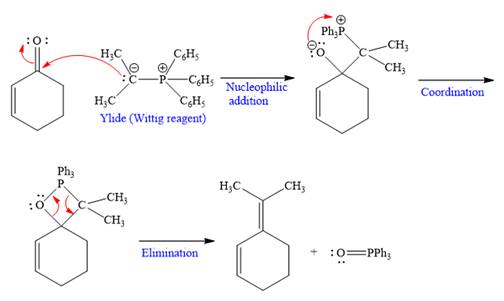
Explanation of Solution
The given nucleophile ylide is highly reactive and adds irreversibly to the
In the first step, the given highly reactive ylide attack on the carbonyl carbon of the
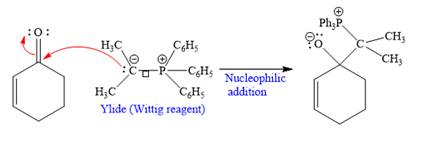
In the second step, the anion coordinates with
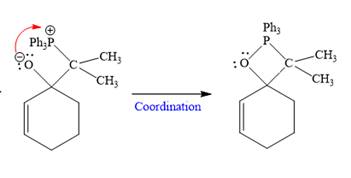
In the last step, Eliminates
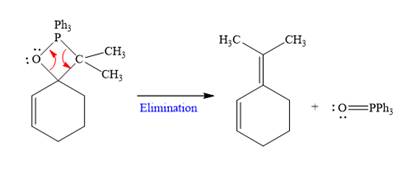
Nucleophilic addition of ylide (Wittig reagent) to the
(c)
Interpretation:
The detailed mechanism for the given reaction is to be drawn and the major product of the reaction is to be predicted.
Concept introduction:
The addition reaction mechanism dominates on whether the nucleophile adds to the carbonyl carbon reversibly or irreversibly. Nucleophilic addition is irreversible or reversible depends on charge stability. Nucleophilic addition tends to be irreversible if the negative charge that develops in the adduct is substantially better stabilized than it is in the nucleophile. Nucleophilic addition to a carbonyl carbon tends to be irreversible when it involves a very strong nucleophile like
Answer to Problem 17.24P
The major product and detailed mechanism for the given reaction are:
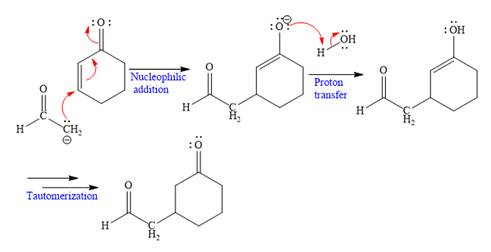
Explanation of Solution
The nucleophile
In the first step,
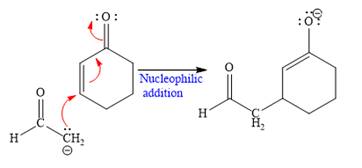
In the second step, this enolate anion is then protonated by an acid workup.
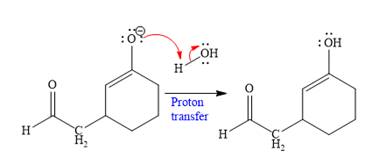
In the last step, tautomerization takes place and produces a ketone with a conjugate addition product.
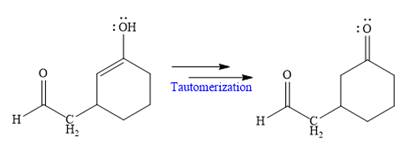
Nucleophilic addition of
(d)
Interpretation:
The detailed mechanism for the given reaction is to be drawn and the major product of the reaction is to be predicted.
Concept introduction:
The addition reaction mechanism dominates on whether the nucleophile adds to the carbonyl carbon reversibly or irreversibly. Nucleophilic addition is irreversible or reversible depends on charge stability. Nucleophilic addition tends to be irreversible if the negative charge that develops in the adduct is substantially better stabilized than it is in the nucleophile. Nucleophilic addition to a carbonyl carbon tends to be irreversible when it involves a very strong nucleophile like
Answer to Problem 17.24P
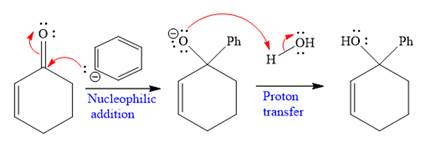
Explanation of Solution
The given nucleophile
In the first step,
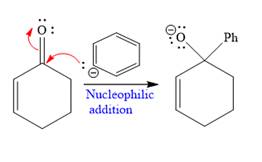
In the second step, this anion is then protonated by acid workup and formed a direct addition product.
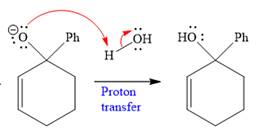
Nucleophilic addition of Grignard reagent to the
(e)
Interpretation:
The detailed mechanism for the given reaction is to be drawn and the major product of the reaction is to be predicted.
Concept introduction:
The addition reaction mechanism dominates on whether the nucleophile adds to the carbonyl carbon reversibly or irreversibly. Nucleophilic addition is irreversible or reversible depends on charge stability. Nucleophilic addition tends to be irreversible if the negative charge that develops in the adduct is substantially better stabilized than it is in the nucleophile. Nucleophilic addition to a carbonyl carbon tends to be irreversible when it involves a very strong nucleophile like
Answer to Problem 17.24P
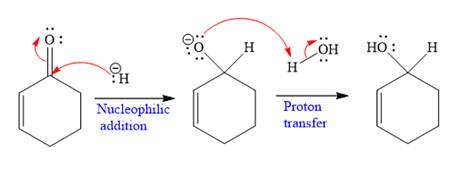
Explanation of Solution
The given nucleophile
In the first step,
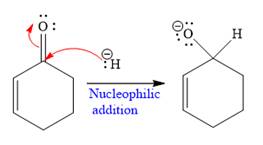
In the second step, this anion is then protonated by acid workup and formed a direct addition product.
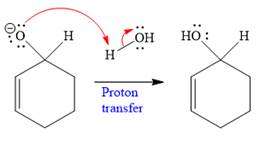
Nucleophilic addition of
Want to see more full solutions like this?
Chapter 17 Solutions
EBK ORGANIC CHEMISTRY: PRINCIPLES AND M
- Indicate the products of the reaction of Cycloheptanone with pyrrolidine (cat. H+). Draw the structures of the compounds.arrow_forwardIndicate the products of the reaction of 2-(3-aminopropyl)cyclohexan-1-one with H2SO4. Draw the structures of the compounds.arrow_forwardIndicate the products of the reaction of 2-cyclopentyl-2-methyl-1,3-dioxolane with H3O+. Draw the structures of the compounds.arrow_forward
- Question 4 For the molecule shown below, (7 marks): A) Sketch the Newman projection for the view looking along the bond from the perspective of the arrow. B) Then, draw the Newman projection for each 60° rotation along the bond until it returns to the starting point. C) Clearly indicate which Newman projection is the one we see in the structure shown below, and clearly indicate which Newman projection is the highest in energy and which is the lowest in energy. H H Me 'H Me Mearrow_forwardDraw the major product of this reaction. Ignore inorganic byproducts and the amine side product. 'N' 1. NaOH, heat 2. Neutralizing work-up Select to Drawarrow_forwardSubmit Problem 3 of 10 Draw the major product of this reaction. Ignore inorganic byproducts and the amine side product. O 'N' NH 1. NaOH, heat 2. Neutralizing work-up Select to Drawarrow_forward
- b) Certain cyclic compounds are known to be conformationally similar to carbohydrates, although they are not themselves carbohydrates. One example is Compound C shown below, which could be imagined as adopting four possible conformations. In reality, however, only one of these is particularly stable. Circle the conformation you expect to be the most stable, and provide an explanation to justify your choice. For your explanation to be both convincing and correct, it must contain not only words, but also "cartoon" orbital drawings contrasting the four structures. Compound C Possible conformations (circle one): Детarrow_forwardLab Data The distance entered is out of the expected range. Check your calculations and conversion factors. Verify your distance. Will the gas cloud be closer to the cotton ball with HCI or NH3? Did you report your data to the correct number of significant figures? - X Experimental Set-up HCI-NH3 NH3-HCI Longer Tube Time elapsed (min) 5 (exact) 5 (exact) Distance between cotton balls (cm) 24.30 24.40 Distance to cloud (cm) 9.70 14.16 Distance traveled by HCI (cm) 9.70 9.80 Distance traveled by NH3 (cm) 14.60 14.50 Diffusion rate of HCI (cm/hr) 116 118 Diffusion rate of NH3 (cm/hr) 175.2 175.2 How to measure distance and calculate ratearrow_forwardFor the titration of a divalent metal ion (M2+) with EDTA, the stoichiometry of the reaction is typically: 1:1 (one mole of EDTA per mole of metal ion) 2:1 (two moles of EDTA per mole of metal ion) 1:2 (one mole of EDTA per two moles of metal ion) None of the abovearrow_forward
- Please help me solve this reaction.arrow_forwardIndicate the products obtained by mixing 2,2-dimethylpropanal with acetaldehyde and sodium ethoxide in ethanol.arrow_forwardSynthesize 2-Ethyl-3-methyloxirane from dimethyl(propyl)sulfonium iodide using the necessary organic or inorganic reagents. Draw the structures of the compounds.arrow_forward
 ChemistryChemistryISBN:9781305957404Author:Steven S. Zumdahl, Susan A. Zumdahl, Donald J. DeCostePublisher:Cengage Learning
ChemistryChemistryISBN:9781305957404Author:Steven S. Zumdahl, Susan A. Zumdahl, Donald J. DeCostePublisher:Cengage Learning ChemistryChemistryISBN:9781259911156Author:Raymond Chang Dr., Jason Overby ProfessorPublisher:McGraw-Hill Education
ChemistryChemistryISBN:9781259911156Author:Raymond Chang Dr., Jason Overby ProfessorPublisher:McGraw-Hill Education Principles of Instrumental AnalysisChemistryISBN:9781305577213Author:Douglas A. Skoog, F. James Holler, Stanley R. CrouchPublisher:Cengage Learning
Principles of Instrumental AnalysisChemistryISBN:9781305577213Author:Douglas A. Skoog, F. James Holler, Stanley R. CrouchPublisher:Cengage Learning Organic ChemistryChemistryISBN:9780078021558Author:Janice Gorzynski Smith Dr.Publisher:McGraw-Hill Education
Organic ChemistryChemistryISBN:9780078021558Author:Janice Gorzynski Smith Dr.Publisher:McGraw-Hill Education Chemistry: Principles and ReactionsChemistryISBN:9781305079373Author:William L. Masterton, Cecile N. HurleyPublisher:Cengage Learning
Chemistry: Principles and ReactionsChemistryISBN:9781305079373Author:William L. Masterton, Cecile N. HurleyPublisher:Cengage Learning Elementary Principles of Chemical Processes, Bind...ChemistryISBN:9781118431221Author:Richard M. Felder, Ronald W. Rousseau, Lisa G. BullardPublisher:WILEY
Elementary Principles of Chemical Processes, Bind...ChemistryISBN:9781118431221Author:Richard M. Felder, Ronald W. Rousseau, Lisa G. BullardPublisher:WILEY





